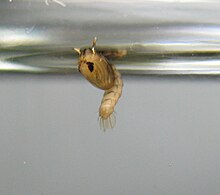

A pupa (from Latin pupa 'doll'; pl.: pupae) is the life stage of some insects undergoing transformation between immature and mature stages. Insects that go through a pupal stage are holometabolous: they go through four distinct stages in their life cycle, the stages thereof being egg, larva, pupa, and imago. The processes of entering and completing the pupal stage are controlled by the insect's hormones, especially juvenile hormone, prothoracicotropic hormone, and ecdysone. The act of becoming a pupa is called pupation, and the act of emerging from the pupal case is called eclosion or emergence.
The pupae of different groups of insects have different names such as chrysalis for the pupae of butterflies and tumbler for those of the mosquito family. Pupae may further be enclosed in other structures such as cocoons, nests, or shells.[1]
- ^ Borror, D. J.; DeLong, Dwight M.; Triplehorn, Charles A. (2004). Introduction to the Study of Insects (Sixth ed.). New York: Holt, Rinehart & Winston. ISBN 0-03-096835-6.